Bird Bingo

Do you like spotting birds? Watching them soar, chase, tease, play and sing? Well, you're not the only one. While we were all spending our days close to home, bird spotting became a popular activity to pass the time. The Vogelbescherming (bird conservation organisation) had never been busier.
While we are no longer at home as much, should this make us forget about the birds that surround us? It's always the right time to play this blissful Bird Bingo. Learn more about the birds in your local area.
How to play Bird Bingo
Download one of the Bingo cards via the button below. Time to go outside and do some bird spotting. Whenever you spot a bird that’s represented on the bingo card, take a picture of it. If you spot a bird that doesn’t feature on the card, grab a picture too as it can count for one of the 'mystery bird' boxes at the bottom of the card. If you enjoy getting creative, you can also make an illustration of a given bird on the card and check it off.
Common swift
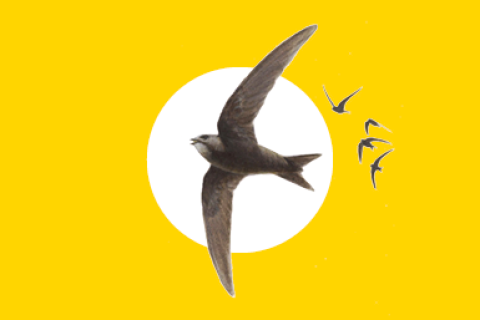
Swifts are wholly dark with only a light throat spot to brighten up their plumage, short, pointy beaks and very short legs. They have characteristic sickle-shaped wings which make the silhouette of a swift in flight iconic and easily recognisable. In flight, they are fast and are usually seen in huge groups. Swifts thrive on diets of small insects and are specialized in catching insects in flight, snatching all of their food in the air. For that, they usually look for the air layers that contain the most insects at the time, sometimes taking them to impressive heights. Swifts spend most of their time in the air but come to nest during the breeding season. For this, they seek out rocky landscapes full of cavities in which they can nest, making houses, office buildings, churches and other structures very appealing. Old buildings, often in the inner city of cities, are particularly popular.
Greenfinch (male)
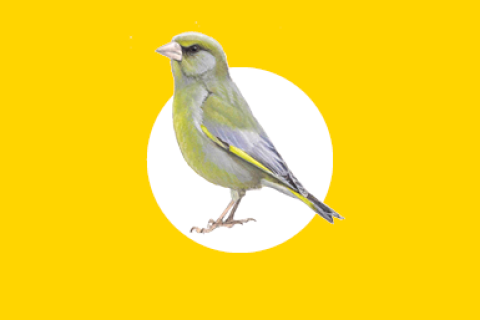
Male greenfinches are a bright green colour with striking yellow edges of the wing feathers and outer tail feathers making them highly visible in flight, while females are a more dulled greyish-green colour. Greenfinches look like sturdy little birds and have a firm conical beak. Living up to their name, the various shades of green in their plumage may be due to the fact that greenfinches are originally a resident of forest edges and semi-open seam vegetation. Unfortunately, their natural habitat is rarer these days so the greenfinch mainly inhabits cultivated landscapes where they seek out dense bushes and eat seeds and fruits. They skin fruit by rotating it in their sturdy beak before eating.
House sparrow
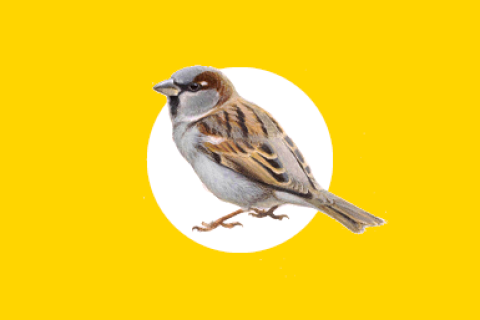
Males and female sparrows differ widely, with males being much darker in color. They also have a black “beard” or patch underneath the peak, which is larger on dominant males than sparrows lower in the ranking. The female is characterized by a fairly uniformly light brown robe, with a striking eyebrow stripe behind the eye and a more yellowy beak. Both male and female sparrows have short, liver-colored legs. These birds exist in various habitats and are a very well-known breeding bird in towns and cities. Their diet is comprised of grains, fruits and seeds, but they also feed their chicks with insects. They build nests out of interesting materials like papers and clothes or whatever else they can grab! Wary of predators, sparrows can be spotted late on top of the trees seeking protection from cats and other creatures.
Great tit
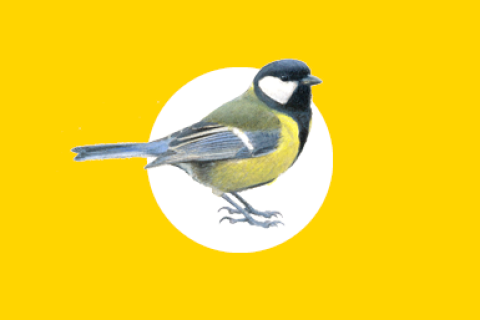
Great tits have a yellow belly with a black central stripe which goes to the tail, greenish backs with blue-gray wings striped in white and glossy black heads with large white cheeks. Great tits love to hang out in bushes and little forests with lots of glades. Their diets are made up mostly of based on little insects, spiders and caterpillars in warmer seasons when they breed and seeds in winter, when insects are scarce. Great tits are even known to occasionally eat other birds in trying times. This bird is easy to observe because they are noisy, aren’t scared of humans and usually tend to stand on observable branches.
Blackbird
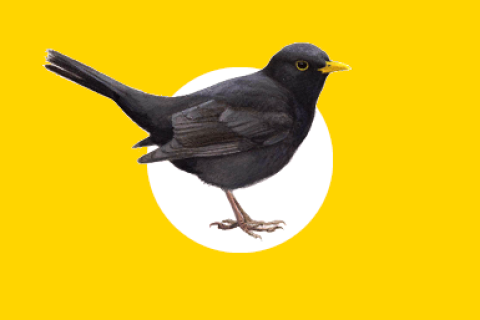
Blackbirds are a medium sized bird, with long tails and yellowy-orange beaks. Males are completely black, while females are dark brown with slightly lighter, brown striped breasts. Young individuals look very similar to adult females, but are often so fluffy that they actually appear larger than their parents! Blackbirds fly low within the bushes, shrubs and hedgerows and can be seen hopping around when on the ground. They are therefore easily observable in parks and gardens. The melody of their song is characteristic, like a flute performing different short stanzas with a sharp sound at the end. Blackbirds begin to sing early in the year, compared to other birds and you can expect to hear its song towards the end of winter.
Blue tit
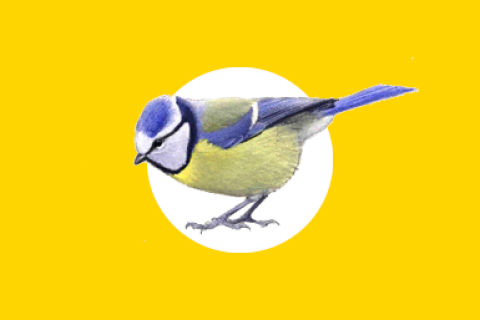
Blue tits have a distinctive blue "cap" and wings, giving them their name, yellow breasts and narrow black eye stripes Males are brighter in color than females and juveniles. They are originally a forest bird that has since adapted to more human-built environments. They like to breed in nest boxes and come close to homes in winter, particularly enjoying fat balls and peanuts. Blue tits can look for food even on the thinnest twigs and do not place much demand on their living environment and are therefore often found in gardens and parks.
Turkish turtle dove

Turkish turtle doves have a slight shape and their plumage is light beige-gray, with a black and white neckband and a contrasting dark red iris. In flight, the light wings and light outer tail feathers stand out. They are almost always found alone or in pairs, although giant flocks can form where there is large quantities of food available. Unlike other birds of their kind, these birds have become very accustomed to urban spaces. Their diet mainly consists of seeds, sprouts and insects. They can be spotted feeding in parks and the gardens of the houses although the highest concentrations of this species are generally found on farms, where they feed on grains from crops or grains used to feed livestock.
Long tailed tit

These birds are the social relative of the tit family and always live in groups outside of the breeding period. They have distinctive white heads with broad black stripes running along the side, converging on their back. As the name suggests, their most distinctive feature is their long tail which is even longer than their body. They are most commonly spotted in forests, parks and garden with good cover as a they require sufficient trees and shrubs as to nab small insects and caterpillars. Generally long tailed tits are homebirds in that they never stray too far from the place where they were born, except for winter when they may roam some kilometers away in search of the seeds on which they survive the harder months.
Robin

Robins are small brown birds with a characteristic orange-red breast and face, while younger birds are spotted light brown. They are territorial individuals and live isolated lives, even during migration and winter, nevel allowing other robbins to be present in the close-by area. This species loves forests, groves, shrubs and hedges. In urban areas, it is easy to find them in gardens and parks, hopping around on the ground looking for insects to eat. Robins love to sing and they usually stand in the treetop branches to do so in winter or during the breeding season. Their song is a melodious sound, while when calling out they just repeat irregularly. While they sing and call through the whole day, they are early risers and especially love singing very early in the morning.
Starling

Starlings are recognisable by their black plumage, with a purple-green pearlesence and striking white speckles (almost resembling stars against the backdrop of deep space!). Starlings are highly social birds and form large flying groups called murmurations, particularly after the breeding season. They are also known to be noisy and are accomplished mimics - copying the calls of other birds in the wild.Their pointed beak is yellow in the breeding season, and turns dark gray / black outside breeding season. Starlings like to nest in holes but are easily visible in parks and gardens where they like to feed in the open on vegetation. While starlings are native to Europe and Asia they are now also common all over the United States having been brought there by ‘Shakespeare enthusiasts’ who wanted all birds mentioned in the famous writer’s works to be present in America .
Chaffinch
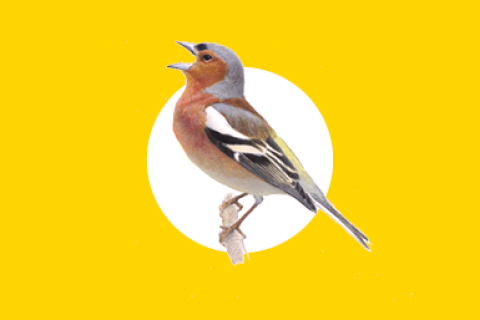
Finches have a short, conical beak. The male in brood has a blue-gray cap, an orange-red breast and cheeks. The tail feathers are black, except for the (white) outer tail feathers. The female is less conspicuous and is sometimes mistaken for a female house sparrow, so watch out! The most striking feature of the finch is the two white wing stripes. Finches love green areas, are are most common in forest, wooded gardens and parks where they can access the seeds and leaf buds they love to eat. They are more common in the northern parts of Netherlands but are relatively common throughout wherever it can find a green environment.
Wren

Wrens are a very small, brown bird with a light eyebrow stripe, a small pointed beak and fine legs. Their ever-flipping, upright tail gives them an air of nervousness. Wrens fly from bush to bush low above the ground with rapid wing beats. Wrens are particularly common in wooded areas of higher sandy soils but are quite content in any area with good thickets of cover. As such, they are also common in the centers of towns and cities with parks that provide foliage. Wherever there is ample cover, wrens will build their nests and they are one of the most common breeding birds in the Netherlands. Despite the wren’s Dutch name (winterkoning or ‘winterking’), these little birds are not particularly resistant to cold winters. With their fine beak, they specialize in eating small insects, caterpillars, spiders, larvae and seeds. They can also extract all kinds of protein-rich animals from small crevices in bark.

